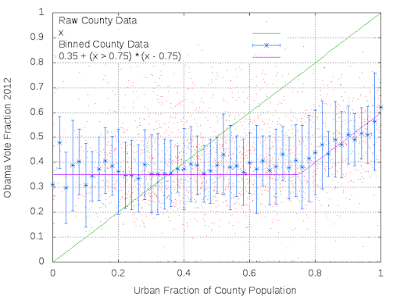More evidence that modern American politics are driven more by the urban/rural divide than any other single factor. https://t.co/ohPeY3Onw5— Dr. John Barentine (@JohnBarentine) October 24, 2016
I saw this tweet this morning as part of a thread, and it didn't quite seem right to me. The urban/rural factor is certainly one component, but it seems like race and income should also be major factors. Unfortunately I didn't fully dig through the census site to find a data set that contains all those variables, so this is just an analysis of the census county based urbanization statistics and the 2012 presidential election outcomes on a county basis. To be completely fair, this is only an analysis of the subset of those two data sets that have identical spelling/spacing for the county names, so 3069 counties from the 3222 available in the census sample. A quick check seems to indicate that Alaska and Puerto Rice aren't matched between the two.
In any case, plotting the vote fraction for Barack Obama as a function of urban population fraction doesn't show a overly strong trend:
 |
| There is a lot of scatter in this relation, but there is an uptick for the most urban counties. |
 |
| The purple "fit" is simply a constant with a break to linear placed to match the binned data. |

No comments:
Post a Comment